by Lisa Cooke | Aug 23, 2016 | 01 What's New, Conferences
The Federation of Genealogical Societies (FGS) Conference for 2016 is “Time Travel: Centuries of Memories” and will be held in Springfield, Illinois. See what your future holds by learning about the past. Genealogy Gems will be there, and you’re going to love our line-up of free 30-minute classes in the exhibit hall (booth #200). Plus, enter to win our Grand Prize drawing! Here are all the details.
Make Your Future Whatever You Want, But Make it a Good One

JMortonPhoto.com & OtoGodfrey.com [CC BY-SA 4.0 (http://creativecommons.org/licenses/by-sa/4.0)], via Wikimedia Commons
This Federation of Genealogical Societies Conference will benefit the novice, the professional, and anyone in between. With over 160 sessions and 72 expert speakers from all over the world, you will be inspired to reach greater heights in all things genealogy.
Each day, a new set of classes will guide you through:
- the U.S. Midwest (regional track)
- the United Kingdom (British Isles and Commonwealth track)
- the continental European research (ethnic track), to give you the latest and greatest in genealogy research.
If you missed early registration, that’s okay. Walk-in registration is available by clicking here. Enjoy all four days of inspiring classes, only attend a day or two, or just meander around the exhibit hall.
Free Stuff in the Exhibit Hall
The exhibit hall is always a favorite place to network and socialize with your genealogy buddies. Wander from booth to booth to see what the future holds for genealogists and gather up all the fun and free swag, too.
Most importantly, Lisa wants to see you for our free sessions that are back by popular demand! With such a positive response last year, Genealogy Gems will once again be hosting a series of free presentations at this year’s FGS conference. Join us in our Genealogy Gems Theater in booth #200 in the exhibit hall. Our 30-minute information-packed sessions will help you think outside the box for greater genealogy success.
Attend any of our sessions and sign-up to receive our free e-book of handouts for all the sessions. Want to plan ahead so you don’t miss a thing? Glance over the schedule below (click the button to download the schedule) and mark your can’t-miss sessions. (Not able to attend? Stay tuned because we will be announcing which sessions will be broadcast live over Periscope for free.)

BONUS: Join Lisa in the FGS theater area of the exhibit hall
Saturday at 12:10 for
Top Google Search Strategies for Genealogists
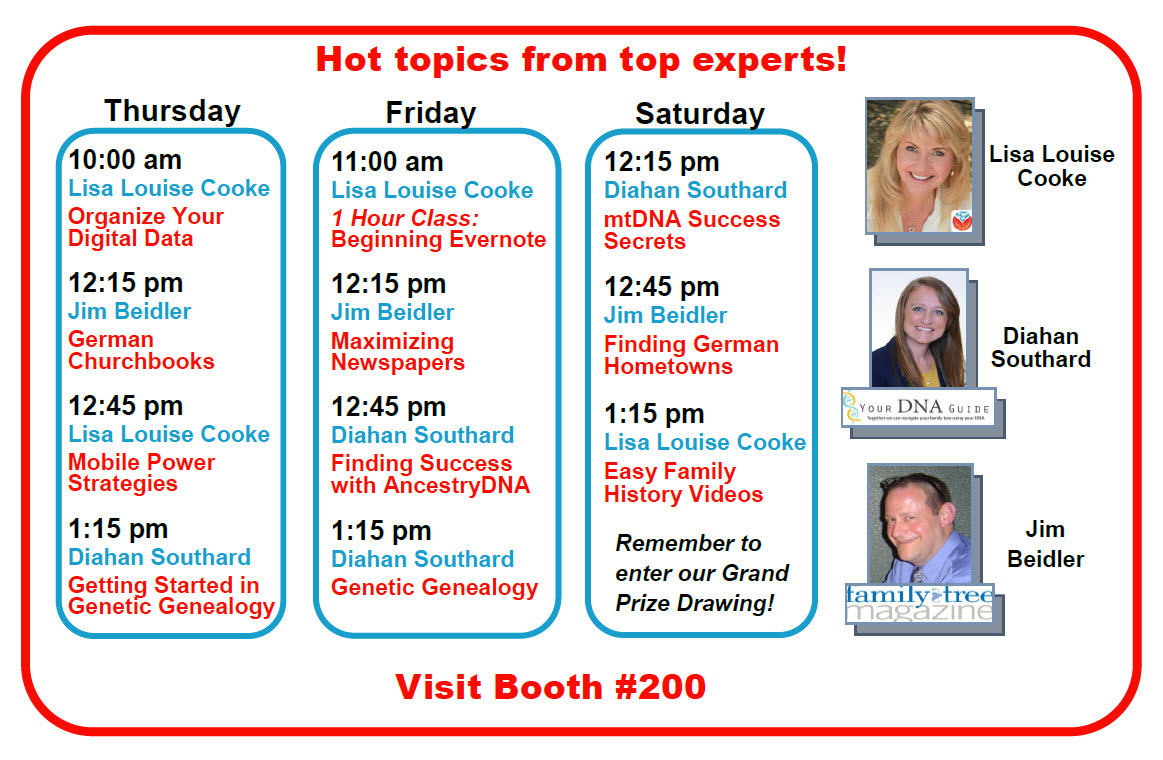
Grand Prize Drawing: Total Retail Value over $210
Presenters at the Genealogy Gems Theater have pitched in for this year’s Grand Prize drawing. The winner will receive:
…from Lisa Louise Cooke’s Genealogy Gems
…from Your DNA Guide Diahan Southard
…from Family Tree Magazine: an e-book bundle valued at about $100
Click here for the Grand Prize entry form, which also gets you the free e-book with all the session handouts. Drop the entry off at booth #200. The winner will be notified by email.

Lisa will of course be presenting lectures during the daily sessions. Jump on over to our website page for even more information about the FGS Conference.
We’re looking forward to seeing you there, friends!
by Lisa Cooke | Aug 20, 2016 | 01 What's New, DNA, Societies |
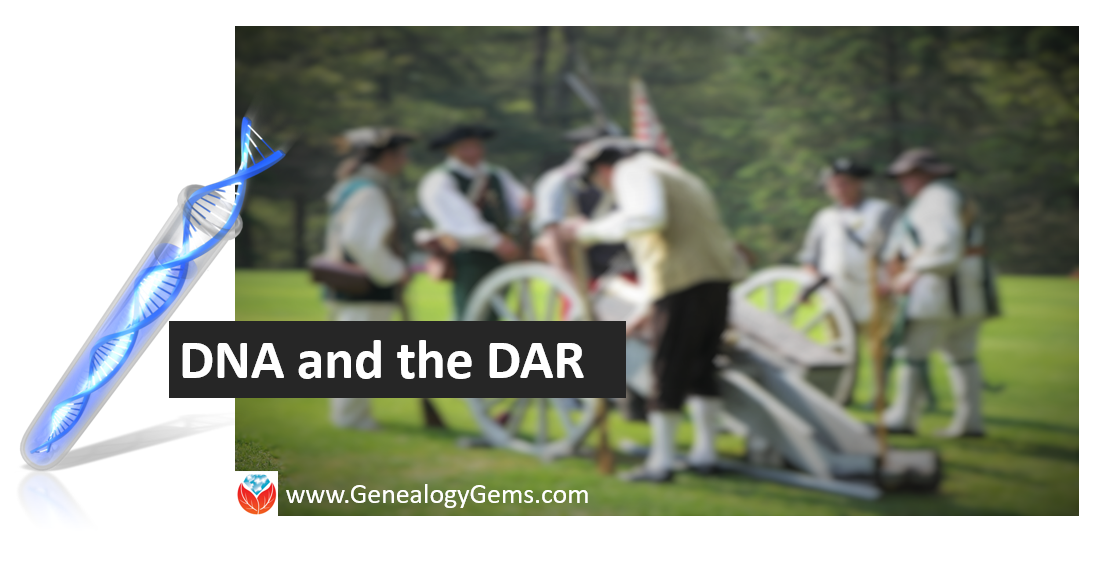
The Daughters of the American Revolution (DAR) accepts limited DNA evidence to prove descent from a Revolutionary War veteran. In my opinion, the DAR DNA policy is a little too limited. Here’s why–and what you can do.
Membership to the Daughters of the American Revolution (DAR) has been a holy grail for U.S. genealogists for 125 years. With its requirement of proof of a “lineal bloodline descendant from an ancestor who aided in achieving American independence” in three categories: birth, marriage, and death, as well as proof of Revolutionary War Service, membership is exclusive to those with an iron-clad paper trail.
That is, until 2014, when the DAR added DNA evidence to its list of acceptable documents proving a relationship to a Revolutionary War ancestor.
What does the DAR DNA Policy Accept?
The DAR only accepts one of the three forms of DNA testing which is the Y chromosome test, or YDNA. The YDNA traces only a direct paternal line, making it a great choice when trying to link living males with their Revolutionary counterparts. This YDNA is basically passed unchanged from generation to generation, making the modern day holder of the YDNA the proud owner of possibly exactly the same YDNA that fought the Redcoats. That’s pretty cool, don’t you think?
The DAR recently announced that to further help those wanting to use their YDNA as part of their application, they have formed a project at Family Tree DNA, the company that provides the YDNA testing. Projects are absolutely the best way to get the most out of your YDNA testing. There are surname projects, location projects, haplogroup (deep ancestral group) projects, and even special interest group projects, such as this one for the DAR.
While the results of the testing are only available to members of the group, the statistics page gives us an idea of the scope of this project. They currently have 1,242 total members and what looks to be about 430 YDNA tests completed (though it is admittedly difficult to tell based on the chart online.) This means if you think your paternal line may be a candidate for the DAR, you can have a representative of your line tested and compared to the group. If you find a match, you will have relative certainty that you do connect to that Patriot, and can then be more confident in your traditional research in pursuit of the necessary paper connections.
In April the DAR opened up project membership to include mtDNA and autosomal DNA. They will not be using these two kinds of DNA in their applications (yet), but hopefully this project will pave the way for the addition of those tests in the future (though, for several reasons, inclusion of these tests in the application process will be more difficult.)
Though, in all honesty, they have made the YDNA process difficult enough. Let’s say that you are actually able to trace down multiple generations to find a direct male descendant of your Revolutionary guy to be tested, an individual who is, the DAR mandates, “sharing your maiden name or your mother’s maiden name,” and you convince that unassuming relative to give up his saliva, you still are only half way there. The DAR guidelines also state that you have to have a second individual who is “a descendant of the same Revolutionary War ancestor through a different unbroken male lineage that has been previously proven on a DAR application…” (I added the emphasis here.)
A Practical Example of the DAR DNA Policy
OK, so let’s say you are a genealogical whiz and, let’s face it, you were lucky, and you find two such candidates and have them tested.
Well, the DAR tells us that those two men must match EXACTLY on the 37 YDNA markers tested. Now there is no telling when that YDNA might experience a mutation. So to me it seems a little unfair to require perfection. So it is possible, that even after all the work of finding the right guys to be tested, the test itself may work against you, as even one difference is enough to keep this YDNA off of your application, at least for now.
So while I applaud the DAR for using YDNA testing at all, and for spearheading a special interest project at Family Tree DNA, the reality is that the limitations of direct paternal line genealogy and the requirements of testing make it unlikely that very many will be able to take advantage of the YDNA in their DAR applications.
However, there are a few things you can take away from this article now:
- First, collect those DNA samples whenever you can, especially for key relatives, like your paternal line and the oldest living generation (whose DNA is less likely to have experienced any mutation.)
- Second, keep your research paper trail strong. Nothing in the near future of the genetic genealogy industry tells us that distant relative connections (like to your Revolutionary War ancestor) will be provable by DNA alone.
- And third, definitely look at crowd-sourced studies for your particular DNA. Those surname, location, haplogroup, and special interest group projects I mentioned from FTDNA are just some of the ones that might help your research—or that you could use to help someone else’s. I’ve talked about these studies before: click here to read about them.
My Complete DNA for Genealogy Research Guide Series
I am Diahan Southard, Your DNA Guide, and the author of a series of genetic genealogy quick guides. My guide called Y Chromosome DNA for the Genealogist is the perfect tool to help guide you through the testing and analysis process. Click here to learn more about this guide and here for all of my guides, or click here to learn more about my series of how-to videos, also available to Gems fans for a special price.
Thanks for sharing this post with your genealogy friends who do DNA research (especially those who may have Revolutionary War ancestors!)
by Lisa Cooke | Aug 19, 2016 | 01 What's New, British, Records & databases |
England emigrants to its U.S. colonies appear in new genealogy records online this week. Also: the 1891 New South Wales census; Czech church, land and school records; English parish records; and U.S. collections from the Freedmen’s Bureau, Marine Corps, Coast Guard and New England towns and cities.
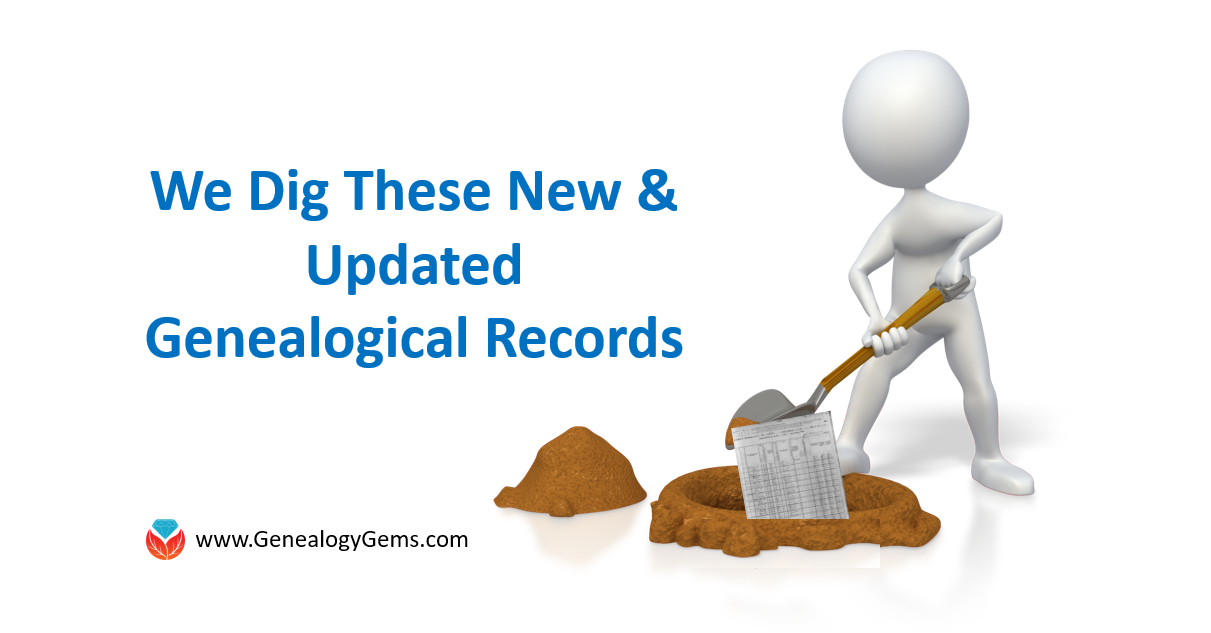
Australia – New South Wales census
Findmypast.com has published over 200,000 records from the 1891 New South Wales census. The census collectors’ books are the source, as these are the only surviving documents. “While they provide less detail than a full census would, they can still be a useful aid to historians and genealogists alike in placing people at a specific moment in time,” states the collection description. “Each result will provide you with a transcript and image of the original collector’s books from the 1891 census. Original images may provide you with additional details, such as the number of individuals living in the same household or the number of residents who were Aboriginal or Chinese.”
Czechoslovakia – Church, Land and School
FamilySearch.org has added to its collection of Czech Republic Church Records spanning more than 400 years (1552-1963). You’ll find “images and some indexes of baptisms/births, marriages, and deaths that occurred in the Roman Catholic, Evangelical Lutheran, and Reformed Church parishes, as well as entries in those registers for Jews.” These are taken from parish registers and synagogue records now in regional archives. Though not fully indexed, the browse-only records number over 4 million! (Click here to learn how to use browse-only collections on FamilySearch.org; remember you can use the FamilySearch wiki for help in translating records in another language.)
FamilySearch has also added more than 850,000 browsable images to its existing collection of Czech Republic Land Records 1450-1889 and more than a million browsable images to the existing collection Czech Republic School Registers 1799-1953.
England Emigrants
Remember recently when we blogged about emigrant records, or those created about people leaving a country? Ancestry.com recently posted a new database called Emigrants in Bondage, which it says is “the most important list of ships’ passengers to be published in years.” Indexed are names of “more than 50,000 English men, women, and children… sentenced to be deported to the American colonies for crimes ranging from the theft of a handkerchief to bigamy or highway robbery.” The collection dates cover 1614 to 1775, after which time the British empire was not permitted to ship its “undesirables” to U.S. shores.
England – Parish records – Staffordshire and Sussex
Findmypast has added to its collections of church vital records for Staffordshire, England. Its browsable parish registers, 1538-1900 now includes 300,000 full-color page-by-page images. Separate databases of baptisms, wedding banns, marriages and burials have also been updated.
Also, more than 1.2 million indexed records have been added to FamilySearch’s collection of England, Sussex, Parish Records, dating 1538-1910. Sussex parish registers contain baptisms, marriages/banns, and burials. Date ranges of available records vary by locality; you will want to use the coverage table at the FamilySearch wiki to see what’s available.
U.S. – Freedmen’s Bureau Records
Now that the Freedmen’s Bureau collections have been fully indexed, FamilySearch is dumping them onto its website in batches. This week, they added these new databases:
U.S. – Military
FamilySearch.org has added just over 4 million indexed records to its database of United States Muster Rolls of the Marine Corps (1798-1937). The collection is described as an “index and images of muster rolls of the United States Marine Corps located at the National Archives. The records are arranged chronologically by month, then by post, station or ship.”
This week, the Fold3.com blog reminds us of its Coast Guard collections, in honor of the Coast Guard’s 226th birthday. Hundreds of thousands of search results on the site relate to Coast Guard history, from disapproved Navy survivors pension files to photos dating to the Civil War; accounts of shipwrecks or accidents, WWII war diaries for several units, images of insignia and Navy cruise books.
U.S. – New England
FamilySearch has posted a new index of New Hampshire Vital and Town Records Index for the years 1656-1938. It contains shy of half a million records of births, marriages and deaths. Entries were sourced from multiple archives in New Hampshire; the citation for each record is included in the index entry at the bottom of the record screen.
The New England Historic Genealogical Society has announced improvements to its databases for three New England cities, which now include more searchable fields and images. “Hartford, CT: General Index of Land Records of the Town of Hartford, 1639-1839, is now searchable by grantee and grantor name, and results provide the record type and volume and page of the record (available on microfilm at the Connecticut State Library). Boston, MA: Births, 1800-1849, and Dover, NH: Vital Records, 1649-1892, are now searchable by first name, last name, record type, family member names, date, and location.”
by Lisa Cooke | Aug 17, 2016 | 01 What's New, Video
Here’s an inspiring example of a quick and easy way to tell your story. Every one of us is deeply connected to history through our family stories. In fact, exploring your family history story can help you learn more about your place in history and what makes you, you.
Tell Your Family History Story with Animoto
Were you one of those kids sitting in history class bored to tears? Was the common teenage mantra “what’s this got to do with me?” running through your brain? While the teacher’s lecture may have seemed disconnected, nothing could have been further from the truth. Every one of us is deeply connected to history through our family stories. In fact, exploring your family history story can help you learn more about your place in history and what makes you, you.
(Full disclosure: This post contains affiliate links and I will be compensated if you make a purchase after clicking on my links. Thank you for supporting the Genealogy Gems blog!)
We all have a story to tell about our place in history and Animoto is an easy and powerful way to tell that family history story. I’ve been sharing my thoughts on creating family history stories on my Genealogy Gems Podcast and in videos on my Genealogy Gems YouTube channel. One of my listeners and viewers, Doug Shirton, has enthusiastically embraced the idea of video storytelling and recently shared his video with me.
is an easy and powerful way to tell that family history story. I’ve been sharing my thoughts on creating family history stories on my Genealogy Gems Podcast and in videos on my Genealogy Gems YouTube channel. One of my listeners and viewers, Doug Shirton, has enthusiastically embraced the idea of video storytelling and recently shared his video with me.
Doug says “I have been wanting to do a video for a long time…Animoto was so easy.” Take a few minutes and get inspired by watching Doug’s video Genealogy Journey; Doug Shirton by clicking here.
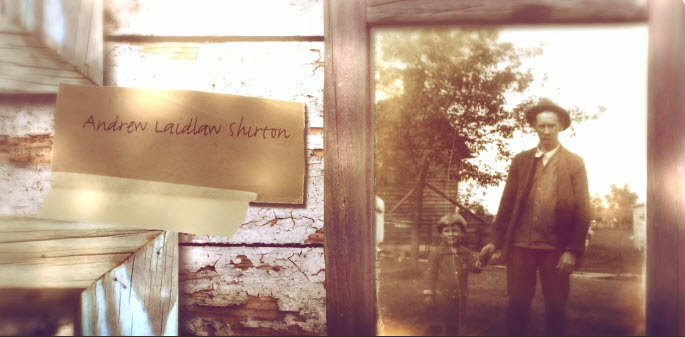
I love the elements that Doug wove into his video. Not only did he include individual photographs of himself and his ancestors, but he also dragged and dropped into his Animoto timeline a full page family tree chart. Doug used the “Rustic” video style (one of my favorites) which is perfectly suited for his old-timey photos.
He also used music in an innovative way to tell his family history story. Rather than settling on just one song, he used portions of multiple tracks. This technique moves the viewer through the emotional levels he was striving to convey.
Adding Music to Your Family History Story
All great movies have a soundtrack! Animoto allows you to choose from their music library or add your own. Adding music to your family history video is very simple. To add additional songs, simply click the plus sign under the timeline. Animoto’s “edit song and pacing” feature makes it easy to get everything to fit perfectly.

MUSIC SEARCH TIP: In addition to being able to upload your own songs, Animoto’s robust music library is brimming with songs that will help you hit just the right note. In addition to the filter boxes, don’t miss the handy search field at the very bottom of the list of filters. Enter a keyword to suit your mood and then scroll back up to the top of the page to pick from the results.
Choosing the Focus of Your Family History Story
Family trees are very far-reaching indeed. So many direct line and collateral lines, often spanning the globe. Doug was wise to select one family history story within his tree: his Ontario, Canada pioneer ancestors.
Focusing on a particular line of your family, or a single story makes creating your video more manageable for you and, frankly, more enjoyable to watch for your viewer. Keeping your video fairly short is also a good idea. Doug’s is just 4 minutes and I recommend going no longer than five. This is particularly important when you plan to share it on social media where attention-spans are short.
Family History Story Ideas
Here are a few ideas of stories you could explore:
- The story of your most recent immigrant ancestor
- A family history story that runs through your family tree, such as three generations of musicians
- How one of your ancestral families survived a natural disaster like the Johnston Flood or the Great San Francisco Earthquake
- The history of a first name that was used over multiple generations in your family
The idea here is to select a family history story that is short, thematic, and compelling to watch.
Need More Ideas?
Visit my How to Create Family History Videos page for more ideas and step-by-step instructions for videos with Animoto, There’s no better time than now to tell your story! We would love for you to share your family history story video on our Facebook page.
Here’s the book that will help you cultivate and record your story: Story of My Life: A Workbook for Preserving Your Legacy.
Disclosure: This article contains affiliate links and Genealogy Gems will be compensated if you make a purchase after clicking on these links (at no additional cost to you). Thank you for supporting Genealogy Gems!
by Lisa Cooke | Aug 15, 2016 | 01 What's New, Family Tree Magazine, Genealogy Gems Podcast
Wow! We can’t thank you enough for your overwhelming support of The Genealogy Gems Podcast, website, blog, and our YouTube Channel. Family Tree Magazine listed Genealogy Gems among their 101 best genealogy websites for 2016!
Genealogy Gems Named One of the Best for 2016
Family Tree magazine writer David A. Fryxell wrote the post last week listing the 101 Best Websites for 2016. He said they were searching for “new frontiers in online genealogy [and] sites not afraid to innovate at warp speed.” As you know, we really enjoy sharing new and innovative ways to use technology around here and we are delighted they noticed!
To organize the list of 101 best genealogy websites, Family Tree Magazine broke it down into several categories. Some of the categories included, Best Websites for Exploring Your Ancestors’ Lives, Best Genetic Genealogy Websites, and Best Sites for Sharing Your Genealogy. Genealogy Gems fell into the Best Genealogy News and Help Websites of 2016 and it is because of you, our readers and listeners. Thank you!
Another Milestone: 2 Million Downloads!
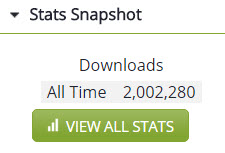
Above: Podcast Stats Screenshot
As if we weren’t elated enough, The Genealogy Gems Podcast hit 2 million downloads earlier this month! We could never have accomplished this goal without your enthusiasm and support. Thank you for listening, for sharing, and for keeping us engaged in bringing you the best in genealogy and family history research tools.
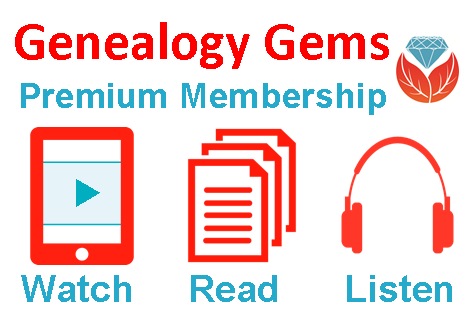 Did you know there are two versions of The Genealogy Gems Podcast? Anyone can listen to our free podcasts (nearly 200 to date) and Premium Members can currently listen to an additional 137 exclusive Premium Episodes.
Did you know there are two versions of The Genealogy Gems Podcast? Anyone can listen to our free podcasts (nearly 200 to date) and Premium Members can currently listen to an additional 137 exclusive Premium Episodes.
If you enjoy our free podcast, you’re going to love the Premium Episodes. Click here to peruse our vast archive, rich with family history innovation and inspiration. Premium episodes go more in depth and are commercial free!
Also included in Premium Membership is over thirty of Lisa’s most popular genealogy classes on video, complete with downloadable handouts.
What’s New for Genealogy Gems
No time to sit on our laurels because we have loads of gems in the works for the coming year. Would you like to feel more focused and organized? You’ll be hearing detailed strategies for streamlining your family history efforts and reducing overload and disorganization.
Have you seen Lisa’s Tech Tips video series? She launched it this summer to rave reviews and she’s got more incredible strategies on the way to help you save time and get better research results.
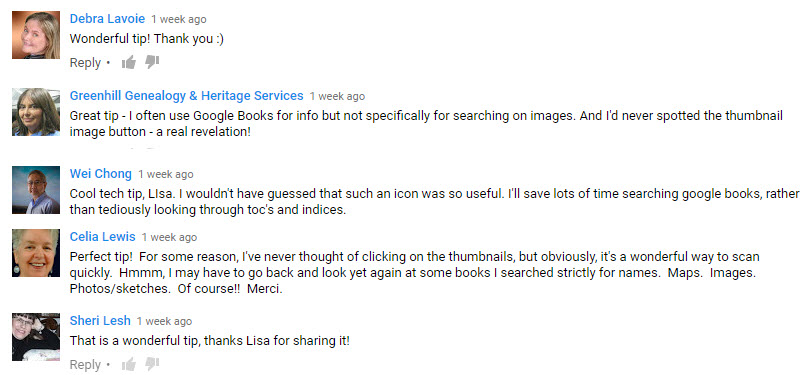
Start watching and learning today here at our Genealogy Gems YouTube channel. And to keep in the loop, click the Subscribe button while you’re there!











 Did you know there are two versions of The Genealogy Gems Podcast? Anyone can listen to our
Did you know there are two versions of The Genealogy Gems Podcast? Anyone can listen to our 



